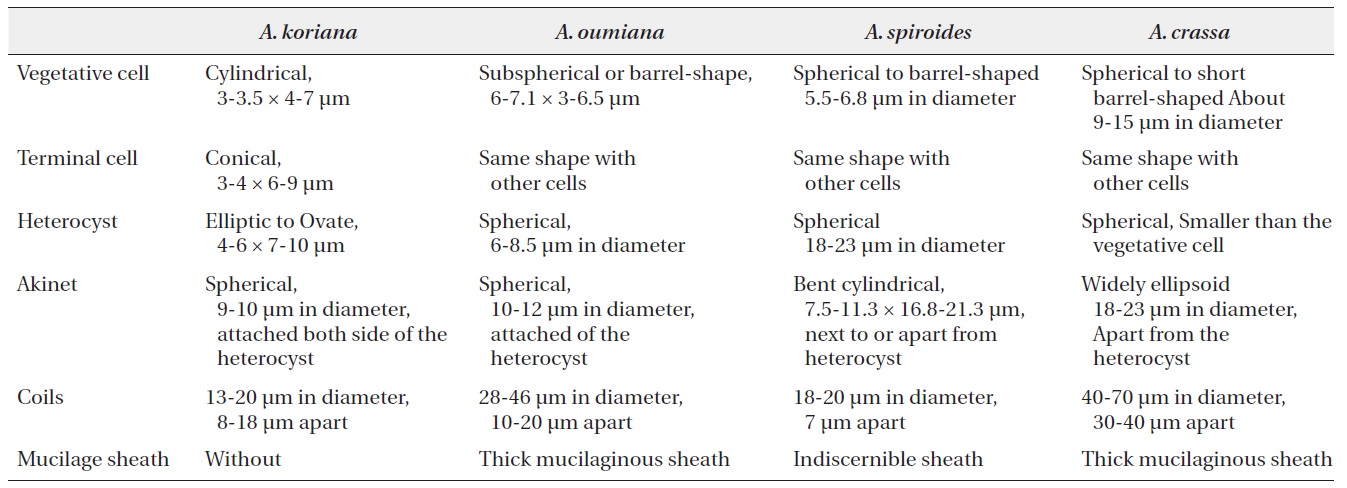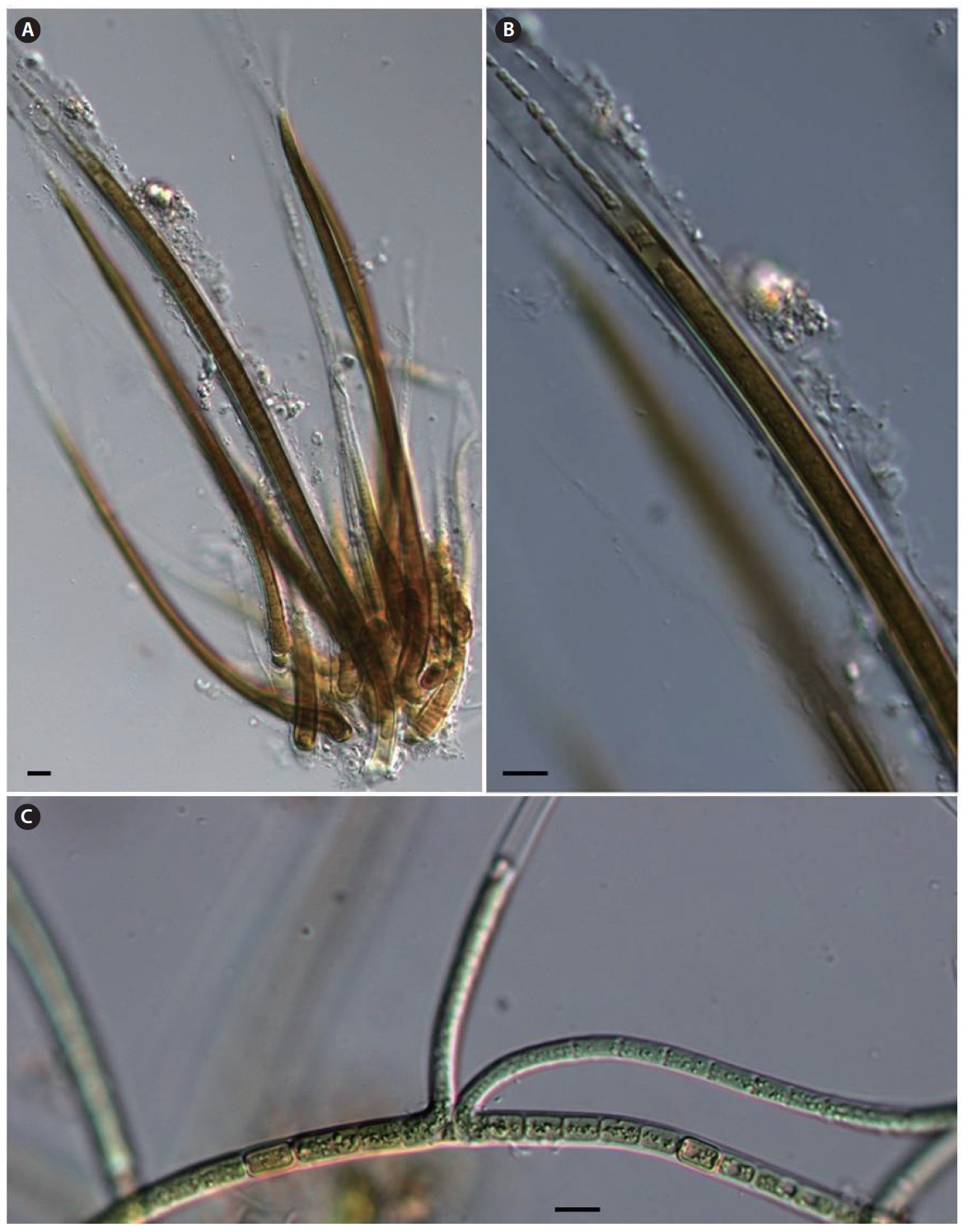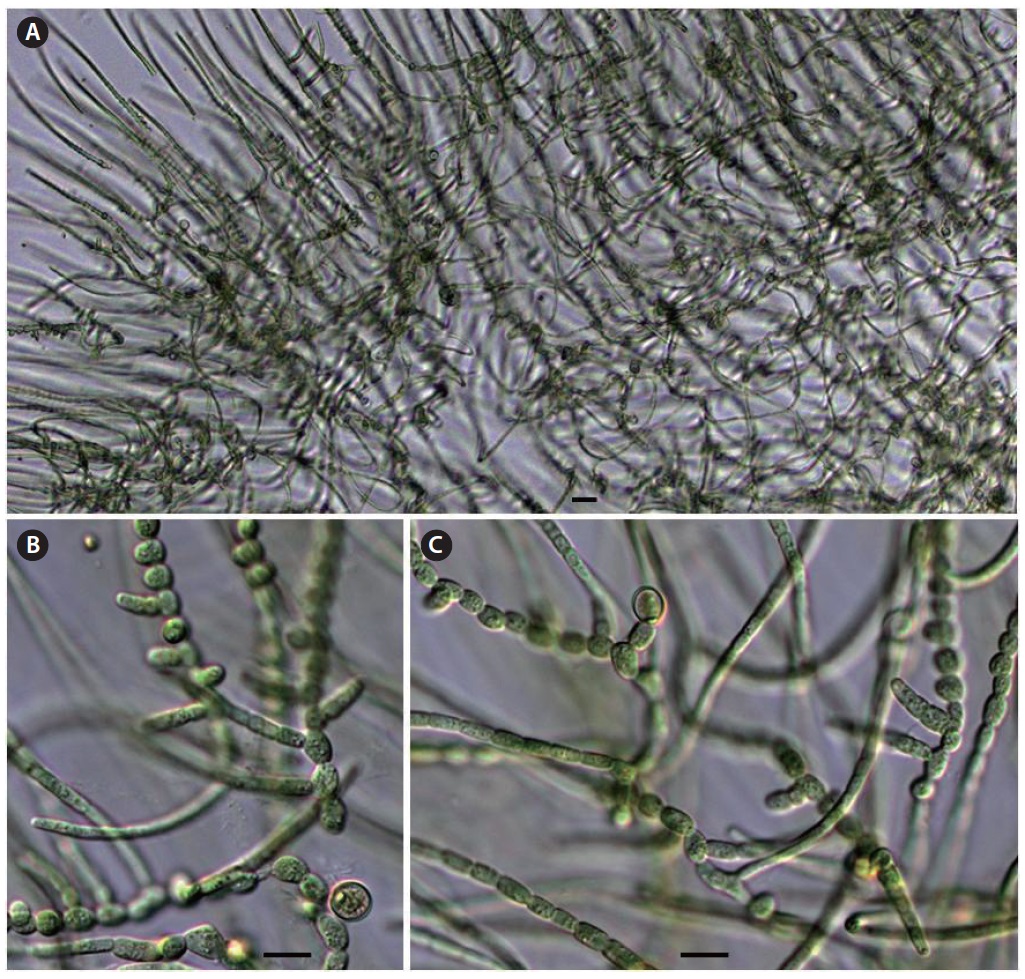



The present study summarizes the occurrence, distribution and autecology of 12 taxa of the class Cyanophyceae collected from several swamps, reservoir and highland wetlands in South Korea from 2009 to 2012. A new species, Anabaena koreana sp. nov. and 11 taxa of blue-green algae newly recorded are described and illustrated. Anabaena koreana is similar to A. oumiana, A. spiroides and A. crassa in that the trichomes form regular coils. However, A. koreana is distinguished from these three species by the morphological characteristics of the vegetative cell, heterocyst, and akinet shape and size. This study considers 12 blue-green algal species, including a new species, Anabaena koreana sp. nov. and 11 species that are recorded for the first time in the Korean freshwater algal flora. Among them, the genus Nostochopsis Wood ex Bornet et Flahault 1886 had not previously been recorded in Korea.
Many investigations of the freshwater algal flora have been conducted by a number of workers in various regions of Korea since Kawamura (1918) reported a species of
The importance of biological diversity has been emphasized, and the discovery of indigenous species for securing the sovereignty over biological resources is recognized as an urgent national task. Therefore, studies on the freshwater algae of uninvestigated regions in Korea including unusual environments (e.g., highland moorlands, mountain sphagnum bogs, wet-lands and crater) are required.
In this study, more than 500 samples were collected from varies water bodies throughout the country and investigated to establish freshwater algal flora of Korea. This study reports 12 species of blue-green algae for the first time in Korea including a new species,
Over 500 samples were collected from various wetland habitats ranging from oligotrophic to eutrophic reservoirs, lowland swamps, acidic mountainous wetlands, sphagnum bogs and orum (crater, very small and shallow caldera lakes) from 2009 to 2012. The samples were obtained by means of plankton net (mesh size 25 µm), spoid, or by squeezing submerged macrophytes, and living materials was examined immediately. After the initial examination, materials were fixed with 5% formalin for permanent preservation and detail identification. Microscopic examinations were made at ×200 to ×1,000 magnification with an Axio Imager microscope (A2; Carl Zeiss, Oberkochen, Germany). Water temperature, pH, and conductivity were measured in the field with a HI8314 membrane pH meter (Hanna instruments, Smithfield, RI, USA) and a HI9835 EC meter (Hanna instruments). One new species and 11 species which had not previously been recorded from the Korean freshwater algal flora are described and illustrated with microscopy. All material was deposited at the National Institute of Biological Resources (NIBR) and Department of Biology, Kyungpook National University.
Aphanothece microscopica Nageli (
Synonyms:
References: Komárek and Anagnostidis 2008a, p 84, fig. 72-73; John et al. 2011, p 45, pl. 9, fig. D.
Description: Colony mucilaginous, bright blue-green or yellow-green, initially small, spherical to ellipsoidal, later becoming diffluent margin and irregularly shaped, up to 2 mm in diameter; cells oblong, more or less ellipsoidal to cylindrical with rounded ends, densely or sparsely arranged in a homogenous, gelatinous matrix, generally densely arranged in the peripheral region and sparsely in the inside of the colony, often with their own indistinct colorless gelatinous envelopes; cells 4-6 µm in diameter, 5-11 µm long.
This species commonly occurs in moorland waters, peaty swamps, pools or in littoral of oligotrophic lakes, rarely subaerophytic on moist peaty soils.
Occurrence: Collected at Sumenmulbaengdi located in middle latitude of Mt. Hanla (33°22′00″N, 126°27′00″E, pH 5.2-6.0, EC 35-52 µs/cm) and Mujechineup of Mt. Jongjok (35°27′40″N, 129°08′30″E, pH 5.5-6.5, EC 25-35 µs/cm).
Cyanothece aeruginosa (Nageli) Komarek (
Synonyms:
References: Komárek and Anagnostidis 2008a, p 49, fig. 28; John et al. 2011, p 58, pl. 14, fig. E.
Description: Cells free-floating in vicinity of submerged plants, sometimes among other algae and bryophytes in swamps and mountain sphagnum bogs or wetlands, solitary or a pair during division; ellipsoid to short cylindrical with widely rounded ends, rarely slightly more oval, occasionally enveloped with a thin mucilaginous layer; cells contents blue-green, rarely brownish-green, usually with obvious fine vacuoles; cells 11-16 µm in diameter, 15-22 µm long.
This species commonly occurs in clear, cold moorland waters, mountain sphagnum bogs or wetlands.
Occurrence: Collected at Sumenmulbaengdi located in middle latitude of Mt. Hanla (33°22′00″N, 126°27′00″E, pH 5.2-6.0, EC 35-52 µs/cm), Mujechineup of Mt. Jongjok (35°27′40″N, 129°08′30″E, pH 5.5-6.5, EC 25-35 µs/cm), and Yongneup of Mt. Daeam (38°13′00″N, 128°07′30″E, pH 6.0-7.0, EC 18-35 µs/cm).
Oscillatoria kawamurae Negoro (
References: Komárek and Anagnostidis 2008b, p 598, fig. 895; Yamagishi and Akiyama 1996, p 61.
Description: Trichomes free-floating, straight, with uniformly parallel sides, nearly not attenuated at apex, not constricted at the cross walls; end cells flatly rounded or slightly capitate but without a thickened wall; cells violet or brownish pale-green in color, with minute granules filling in entire cells, and 3-4 reddish-brown gas vacuoles which are large, transverse liner and regular, centrally arranged by the cross walls, forming a loose spiral in whole length of the trichome; cells 70-80 µm in diameter, 10-15 µm long.
This species commonly occurs in shallow, mesotrophic to eutrophic water bodies such as old reservoirs and swamps.
Occurrence: Collected at Jangcheok reservoir (35°26′ 10″N, 128°29′05″E, pH 6.8-7.5, EC 103-135 µs/cm) at located in Changnyong county in 18 Aug 2012.
Microcoleus paludosus Gomont ex Gomont (
References: Komárek and Anagnostidis 2008b, p 534, fig. 803.
Description: Filaments solitary or forming dark blue-green filamentous mat; sheath slightly mucilaginous, colourless, broad, open and diffluent at the ends, containing many straight, parallel arranged or rope-like twisted trichomes; trichomes bright blue-green, 4.5-6 µm wide, not constricted at the cross wall, not attenuated at the ends; cells nearly isodiametric or up to 2 times longer than wide, 5-7.5 µm long; apical cells not capitate, rounded conical or rounded.
This species commonly occurs in stagnant waters, on wet rocks and soil, at margin of shallow reservoir.
Occurrence: Collected at Jangcheok reservoir (35°26′ 10″N, 128°29′05″E, pH 6.8-7.5, EC 103-135 µs/cm) located in Changnyong county on 18 Aug 2012.
Nodularia spumigena var. major (Kutz.) Bornet & Flahault (
References: Hirose and Yamagishi 1977, p 85, pl. 36, fig. 8.
Description: Filaments usually in small flocs, free-floating; individual filaments straight, with single trichome and distinct sheath; sheath firm and relatively wide; cells short discoid, length 1/4-1/3 of wide, constricted at the cross wall; Filament 23-25 µm wide, trichome (cells) 17.5-19.5 µm wide, 4.5-6.5 µm long, heterocysts 17.5-20 µm wide, 7-15 µm long, akinets are not observed.
This species rarely occurs together with submerged plants in the margin of mesotrophic to eutrophic swamp or reservoir.
Occurrence: In this study, it collected at Jangcheok reservoir (35°26′10″N, 128°29′05″E, pH 6.8-7.5, EC 103-135 µs/cm) located in Changnyung county on 18 Aug 2012.
Anabaena koreana sp. nov. Han Soon Kim (
Description: Trichomes solitary, free-floating, forming regular coils, without gelatinous sheath; coils about 13-20 µm in diameter, 8-18 µm apart; cells short cylindrical to barrel-shaped, constricted at the cross walls, with
[Table 1.] Morphological characteristics of Anabaena koreana sp. nov., and related taxa

Morphological characteristics of Anabaena koreana sp. nov., and related taxa
gas vesicles, terminal cells conical; heterocysts elliptic to ovate shaped, slightly larger than vegetative cell; akinets spherical, solitary, attaching at one or both sides of the heterocyst. Cells are 3-3.5 µm in diameter, 4-7 µm long. Terminal cells 3-3.5 µm in diameter, 6-9 µm long. Heterocyst 4-6 µm in diameter, 7-10 µm long. Akinets 9-10 µm in diameter.
Type locality: Buje reservoir, Kyungsan city, South Korea (35°47′30″N, 128°53′00″E; pH, 9.4; water temperature, 29°C; EC, 213 µs/cm).
Holotype: Fig. 2A (iconotypus) from material collected on 18 Aug 2009 deposited at the National Institute of Biological Resources (NIBR), Inchon species no. NIBRCY0000000094.
Etymology: The specific epithet
Rivularia globiceps G.S. West (
Reference: Hirose and Yamagishi 1977, p 85, pl. 36, fig. 8.
Description: Colonies hemispherical or subspherical, up to 2 mm diameter, dark blue-green; mucilage soft; trichomes radiate arranged, gradually tapered toward the apex and terminal cells developed with colorless long hair, with basal heterocyst towards the inside of the colony, slightly constricted at cross wall; cells towards heterocyst at the base cylindrical, 6.5-7.5 µm. wide, length up to about 2.5 times of wide (14-22 µm long), midregion cells nearly quadrate; heterocysts only single at the base, globose or subglobose, 12-15 µm long, 10.5-12 µm wide.
This species occurs as an epiphytic on submerged plants in peaty bogs and shallow reservoirs.
Occurrence: Collected at unnamed small pond (36°23′ 00″N, 128°28′00″E, pH 7.0-8.1, EC 118-253 µs/cm) located in Uiseong-gun, Angae-myeon on 22 Sep 2009.
Homoeothrix varians Geitler (
Reference: Komárek and Anagnostidis 2008b, p 598, fig. 895; Yamagishi and Akiyama 1996, p 61.
Description: Thalli growing on submerged substratum; sheath colorless or yellow, with a single trichome; trichomes gradually attenuated toward the end, up to 270 µm long, without constriction at the cross wall, 16-19 µm in diameter at the base; cells flat, 1/3-1/4 as long as broad, 2-3 µm long; heterocyst more or less semi-globose to subglobose, 13-16 µm in diameter.
This species common occurs together with submerged plants in the marginal of mesotrophic to eutrophic swamp or reservoir.
Occurrence: Collected at Woopo swamp (35°33′00″N, 128°25′00″E, pH 7.6, EC 132 µs/cm) located in Changnyung-gun on 17 Oct 2009.
Scytonema hofmannii Bornet et Flahault (
Synonym:
Reference: Hirose and Yamagishi 1977, p 71, pl. 31, fig. 2; John et al. 2011, p 148, pl. 30, fig. J.
Description: Colony cushion-like, widely expended, 1-2 mm high, blackish blue-green; filaments often in bundles, each filament (7)8.5-(12)15 µm wide, sometimes wider, false branches sparse; cells 5-7 µm in diameter, in older parts of trichome mostly longer than wide, in meristem region shorter; typically blue-green. Sheath thin, firm, colorless or yellow to yellow-brown; heterocysts single or in pairs, rounded cylindrical; cells 6-8 µm in diameter, 6-10 µm long; heterocyst 6-8 µm in diameter, 8-12 µm long.
This species commonly occurs in swamps, moorland waters, mountain sphagnum bogs or wet-lands.
Occurrence: Collected at Sumenmulbaengdi (33°22′ 00″N, 126°27′00″E, pH 5.2-6.0, EC 35-52 µs/cm) located in middle latitude of Mt. Hanla on 12 Aug 2010.
Hapalosiphon arboreus W. et G. S. West (
Reference: Hirose and Yamagishi 1977, p 141, pl. 49, fig. 6.
Description: Colony forming a mass of interwoven filaments, composed of creeping main axes and branches perpendicular to main axis; main axis straight or slightly curved, with numerous short branches; branches in a plane perpendicular to the main axis, slightly narrower than main axis; cells of main axis usually quadrate or slightly longer than broad, 7-8 µm long, 5.5-7 µm wide, cells of branches nearly same to main axis cells; heterocysts intercalary in main axis, almost resemble to vegetative cells, quadrate, 5.5-7 µm wide, 7-10.5 µm long; sheath thin and colorless.
This species commonly occurs mixed with other algae or
Occurrence: Collected at 1100 latitude wet-lands (33°21′40″N, 126°27′50″E, pH 6.2, EC 45 µs/cm) located in Jeju Island on 15 Apr 2013.
Hapalosiphon intricatus W. et G. S. West (
Reference: Hirose and Yamagishi 1977, p 143, pl. 50, fig. 1; John et al. 2011, p 155, pl. 33, fig. C; Yamagishi and Akiyama 1989, p 55.
Description: Colony forming a mass of interwoven filaments, composed of creeping main axes and branches perpendicular to main axis; main axis straight or slightly curved, with numerous perpendicular branches; main filaments 4-7 µm wide, branches slightly narrower than main axis; cells usually quadrate, 3-4 µm wide, 5-8 µm long, heterocysts in main axis and branches, ellipsoid or quadrate, 5-6 µm wide, 8-10 µm long; sheath thin and colorless.
This species commonly occurs mixed with other algae
or
Occurrence: Collected at Mulyoungari (33°22′50″N, 126°45′00″E, pH 5.6, EC 36 µs/cm) located in Jeju island, Seogwipo city on 9 Sep 2009.
Nostochopsis lobatus Wood ex Bornet et Flahault (
References: Yamagishi and Akiyama 1989, p 55.
Description: Thallus attached to the substrate, gelatinous, irregularly subspherical, spherical or lobate, with smooth mucilaginous surface, solid mass up to 3 cm in diameter, olive-green or yellowish-green; trichomes irregularly branched, radially arranged in the outer parts, flexuous, entangled in the inner parts; branches lateral (T- or V-shaped), long, many-celled, terminated by slightly narrowed or widened, rounded terminal cells, or very short, cylindrical branches composed with one to several-celled, terminated by heterocysts; basal cells of thallus ellipsoidal to barrel-shaped, 5.4-7.2 µm wide, 7-13 µm long, somewhat irregularly elongated at the slowly growing parts, 4-6 µm wide, 7-10 µm long; heterocysts lateral or terminal on 1-3 celled lateral branch, spherical or subspherical, 5-8 µm wide, 6-10 µm long.
This species commonly occurs as epiphyte in stream of
high speed of a running fluid.
Occurrence: Collected at middle part of Hoecheon stream (35°44′00″N, 128°16′20″E, pH 9.2, EC 365 µs/cm) located in Goryeong county on 2 Sep 2011.
The present study, a new species,





